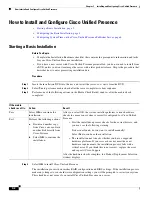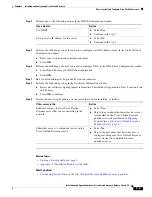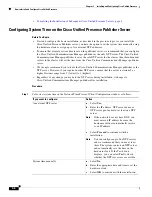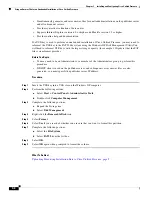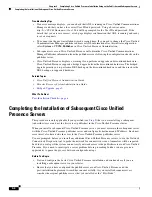
2-7
Installation and Upgrade Guide for Cisco Unified Presence Release 8.0 and 8.5
Chapter 2 Preparing to Install Cisco Unified Presence on a VMware Server
How to Configure the VMware Identity Feature
Procedure
Step 1
Use the identity template you created in the previous procedure to create a new Cisco Unified Presence
instance on a VMware server.
Step 2
Power on the VMware server.
Step 3
Use the AFG tool to create a
platformConfig.xml
file.
Step 4
Insert the
platformConfig.xml
file into a virtual floppy instance (see Related Topics section for a link
to instructions).
Step 5
Mount the .flp file in the floppy drive of the new VMware server.
Step 6
Using console or ssh, sign in to the CLI of the VMware server.
Step 7
Run this command:
utils import config
The system reboots with the new identity
Troubleshooting Topics
If the Cisco Unified Presence proxy domain name is changed in the platformConfig.xml file, you need
to manually change the proxy domain name on Cisco Unified Presence. Perform the proxy domain name
change after you import the AFG .flp file, and after you run the post-installation steps on the Cisco
Unified Presence administration GUI. See the Deployment Guide for Cisco Unified Presence at this
URL for instructions on how to change the proxy domain name:
http://www.cisco.com/en/US/products/ps6837/products_installation_and_configuration_guides_list.ht
ml
Related Topics
•
Creating the Identity Template, page 6
•
For instructions on creating a virtual floppy instance, go to this URL:
http://kb.vmware.com/selfservice/microsites/search.do?language=en_US&cmd=displayKC&exter
nalId=1739
•
Deploying the Identity Template on a Cisco Unified Presence Cluster, page 7
Deploying the Identity Template on a Cisco Unified Presence Cluster
This is a high-level overview of the steps you perform to deploy the identity template on a
Cisco Unified Presence cluster.
Procedure
Step 1
Create two identity templates, one for the publisher Cisco Unified Presence node, and one for the
subsequent (subscriber) Cisco Unified Presence node or nodes. Follow the procedure described in this
module for creating an identity template.
Note
The subscriber template should be a "skip" install that is ready for configuration.


















